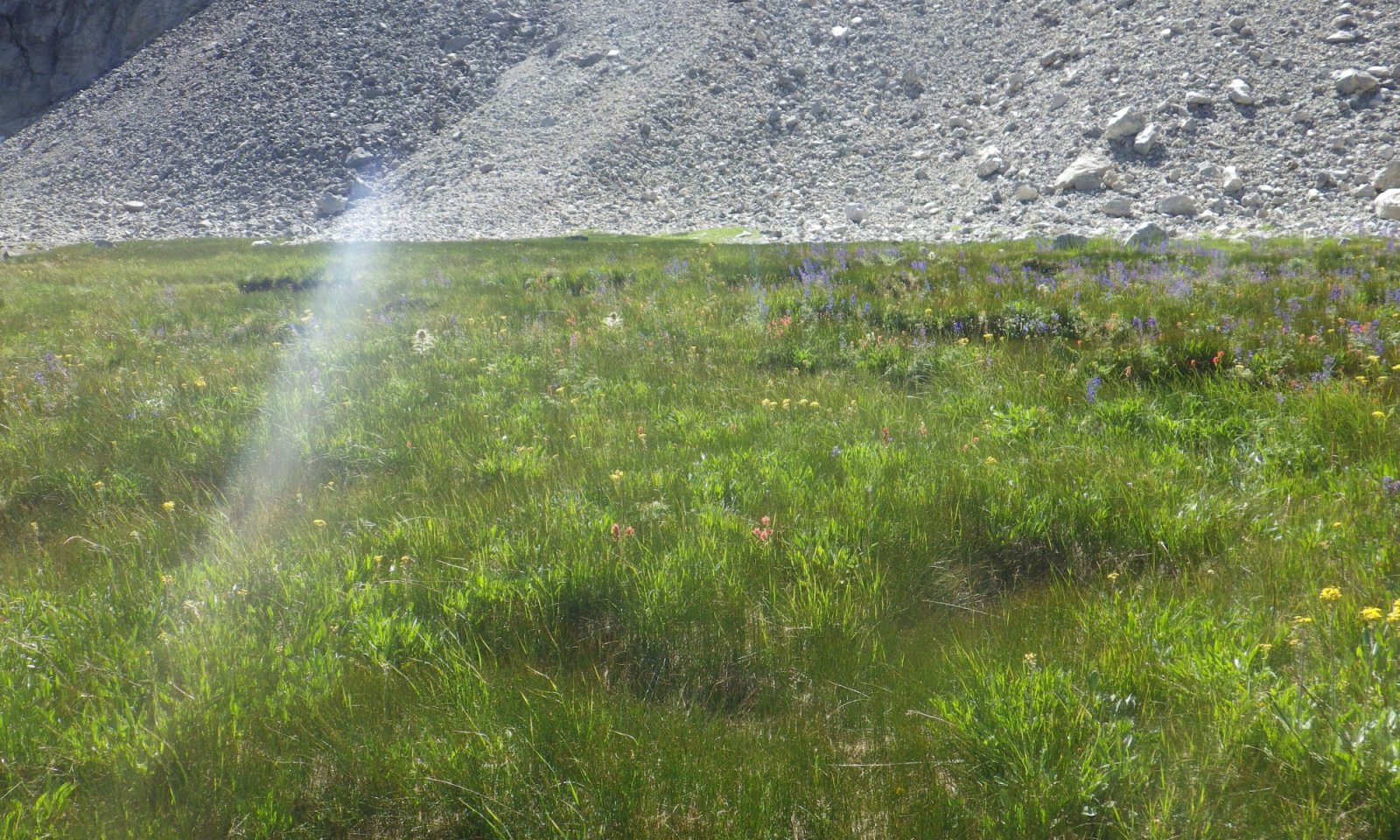
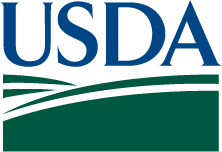
Natural Resources
Conservation Service
Ecological site BX012X02G089
Wet Meadow Lost River Mountains
Last updated: 5/19/2025
Accessed: 12/21/2025
General information
Provisional. A provisional ecological site description has undergone quality control and quality assurance review. It contains a working state and transition model and enough information to identify the ecological site.
MLRA notes
Major Land Resource Area (MLRA): 012X–Lost River Valleys and Mountains
Major Land Resource Area (MLRA) 012X, Lost River Valleys and Mountains, consists of approximately 4.85 million acres in Idaho. MLRA 012X is broken into two Land Resource Units (LRU) based on geology, landscape, common soils, water resources, and plant community potentials. The elevation ranges from approximately 3,600 feet (1,100 meters) in the valleys and extends to the highest point in Idaho, Mount Borah, at 12,662 feet (3,869 meters). Annual precipitation has a significant range from six to 47 inches, with the driest areas in the valley bottoms and the wettest areas on the mountain summits. This MLRA encompasses portions of the Salmon-Challis National Forest, small amounts of private land, as well as other public land managed by the State of Idaho and the Bureau of Land Management. The Continental Divide runs through the Beaverhead Mountain Range directly east of the MLRA and adjacent forests and parks include the Beaverhead National Forest, Custer Gallatin National Forest, Caribou-Targhee National Forest, and Craters of the Moon National Park.
LRU notes
The Lost River Mountain LRU is located on the Lemhi, Lost River, and White Knob Mountain Ranges. These mountain ranges extend from Salmon, Idaho to the north, Craters of the Moon National Monument to the south, the Beaverhead Mountain Range to the east, and the Sawtooth Mountains to the west. This LRU borders MLRA 043B - Central Rocky Mountains, and a small portion of MLRA 010X - Central Rocky Mountains and Foothills.
The geology of this LRU is comprised mostly of colluvium from the Challis Volcanic Group, limestone from the Permian to Mississippian Period, and till from Pleistocene glacial deposits. Additionally, metasedimentary formations from the Proterozoic dominate the Lemhi Range. The elevation range of this LRU is similar to that of the MLRA (approximately 4,000 to 12,500 feet). The boundary of the unit begins where the three mountain ranges meet the valley floor and extends to the mountain peaks. Effective precipitation (estimate of the moisture available for plant use and soil forming processes at a given site) generally ranges between 10 to greater than 36 inches. The soil temperature regimes present are frigid and cryic, and the soil moisture regimes include xeric and udic. The soils for the LRU are dominated by mollisols and inceptisols from limestone and quartzite parent material, as well as glacial till.
Classification relationships
Relationship to Other Established Classification Systems
National Vegetation Classification System (NVC):
2 Shrub & Herb Vegetation Subclass
2.C Shrub and Herb Wetland Subclass
2.C.4 Temperate to Polar Freshwater Marsh, Wet Meadow, & Shrubland Division
2.C.4.Nb Western North American Temperate Freshwater Marsh, Wet Meadow and Shrubland Division
M893 Western North American Montane Marsh, Wet Meadow, and Shrubland Macrogroup
G521 Vancouverian-Rocky Mountain Montane Wet Meadow and Marsh Group
Ecological site concept
This site receives additional water outside of annual precipitation and occurs on slopes of less than 30 percent.
These soils:
o Are not saline, saline-sodic, or sodic
o Are not highly calcareous within the top 50cm
o Have a seasonal water table depth between 0 and 30 centimeters
o Are highly productive
Associated sites
| BX012X02G083 |
Meadow Lost River Mountains This ecological site can occur adjacent to the Wet Meadow site when the seasonal water table is in the 30 to 60cm range of the soil profile. |
|---|---|
| BX012X02G080 |
Dry Meadow Lost River Mountains This ecological site can occur adjacent to the Wet Meadow site when the seasonal water table occurs in the 60 to 100cm range of the soil profile. |
| BX012X02G082 |
Marsh Lost River Mountains This ecological site can occur adjacent to the Wet Meadow site when the depth of the surface organic horizon is 20cm or greater in depth. |
| BX012X02G085 |
Riparian Wet Meadow Lost River Mountains This ecological site can occur adjacent to the Wet Meadow site when the site occurs on a floodplain landform. |
Similar sites
| BX012X02G083 |
Meadow Lost River Mountains The Meadow ecological site has a seasonal water table depth that occurs in the 30-60cm range of the soil profile. |
|---|---|
| BX012X02G080 |
Dry Meadow Lost River Mountains The Dry Meadow ecological site has a seasonal water table that occurs in the 60-100cm range of the soil profile. |
| BX012X02G082 |
Marsh Lost River Mountains The Marsh ecological site often has a seasonal water table at or near the surface but also has a surface organic horizon at least 20cm thick. |
| BX012X02G085 |
Riparian Wet Meadow Lost River Mountains The Riparian Wet Meadow ecological site has a seasonal water table depth of 0-30cm, however, it occurs on the floodplain or stream terrace landform. |
Table 1. Dominant plant species
| Tree |
Not specified |
|---|---|
| Shrub |
(1) Salix |
| Herbaceous |
(1) Carex |
Legacy ID
R012XG089ID
Physiographic features
This site can occur on a variety of low-lying landforms within the mountain landscape. These landforms include stream terraces, drainageways, glacial valley floors, cirque floors, fens, alluvial fans, and swales.
Landscape Definition:
Mountains -- A region or landscape characterized by mountains and their intervening valleys.
Landform Definition:
Stream Terrace: One, or a stepped series of flat-topped landforms of alluvium in a stream valley, that flank and are parallel to the stream channel.
Drainageways: Relatively small, roughly linear or arcuate depressions that move concentrated water at some time.
Glacial Valley Floor: The comparatively flat bottom of a mountain valley predominantly mantled by till but which can grade from glacial scour.
Alluvial Fan: A low, outspread mass of loose materials and/or rock material, commonly with
gentle slopes, shaped like an open fan or a segment of a cone, deposited by a stream (best expressed in semiarid regions) at the place where it issues from a
narrow mountain or upland valley.
Swale: A shallow, open depression in unconsolidated materials that lacks a defined
channel but can funnel overland or subsurface flow into a drainageway.
Cirque Floor: The comparatively level bottom of a cirque, thinly mantled with till and consisting of glacially-scoured knolls and hillocks separated by depressions, flat areas and small lakes.
Seep: An area, generally small, where water outflows slowly at the land surface. Flow rates for seeps are too small to be considered as springs, but reflow and/or lateral subsurface flow keeps the surface or near soil saturated during dry periods.
(Schoeneberger & Wysocki, 2017)
Table 2. Representative physiographic features
| Landforms |
(1)
Mountains
> Stream terrace
(2) Mountains > Drainageway (3) Mountains > Glacial-valley floor (4) Mountains > Alluvial fan (5) Mountains > Swale (6) Mountains > Cirque floor (7) Mountains > Seep |
|---|---|
| Flooding frequency | None |
| Ponding duration | Long (7 to 30 days) to very long (more than 30 days) |
| Ponding frequency | None to frequent |
| Elevation | 7,467 – 8,268 ft |
| Slope | 2 – 9% |
| Water table depth | 12 in |
| Aspect | W, NW, N, NE, E, SE, S, SW |
Table 3. Representative physiographic features (actual ranges)
| Flooding frequency | Not specified |
|---|---|
| Ponding duration | Not specified |
| Ponding frequency | Not specified |
| Elevation | 7,081 – 9,566 ft |
| Slope | 1 – 13% |
| Water table depth | Not specified |
Climatic features
In the Lost River Mountain LRU, both precipitation and temperatures fluctuate significantly throughout the seasons and year to year. Relative effective annual precipitation (estimate of the moisture available for plant use and soil forming processes at a given site) generally ranges between 10 to greater than 36 inches. Average daily temperatures during the growing season (April to August) range from 33 to 57 degrees Fahrenheit. These wide fluctuations in temperature and precipitation are largely due to elevation and aspect differences as well as lower relative humidity and drier air in the mountainous terrain of the LRU. The wettest months in terms of rainfall are May and June. The growing season varies across the LRU in relation to topographical and local conditions; however, generally ranges between 30 to 90 days. Most primary growth occurs from late April through June. Soil temperature regimes include cryic and frigid and soil moisture regimes include xeric, udic, and aquic.
The Wet Meadow ecological site is not associated with a climatic subset requiring a range of effective precipitation. This ecological site is affected by a seasonal water table within 12 inches (30cm) of the soil surface which provides additional moisture, minimizing the impact of annual precipitation. Precipitation and temperature data were taken from Forest Service remote automated weather stations (RAWS) located in the Salmon-Challis National Forest at Bonanza Creek and Copper Basin as well as Snowtel stations located on the Lost River and Lemhi Range. Precipitation data was taken from Snowtel sites that record actual precipitation and may sit at different elevations than a specific Wet Meadow ecological site location. Therefore, these stations may not necessarily be representative of localized conditions.
Table 4. Representative climatic features
| Frost-free period (characteristic range) | 30-60 days |
|---|---|
| Freeze-free period (characteristic range) | 45-75 days |
| Precipitation total (characteristic range) | 15-19 in |
| Frost-free period (actual range) | 25-75 days |
| Freeze-free period (actual range) | 40-100 days |
| Precipitation total (actual range) | 6-32 in |
| Frost-free period (average) | 45 days |
| Freeze-free period (average) | 60 days |
| Precipitation total (average) | 17 in |
Figure 1. Monthly minimum temperature range
Figure 2. Monthly maximum temperature range
Figure 3. Monthly average minimum and maximum temperature
Figure 4. Annual precipitation pattern
Figure 5. Annual average temperature pattern
Influencing water features
The Wet Meadow ecological site has a seasonal water table depth between zero and 30cm (zero and 12 inches). The water table will reside within that range long enough for redoximorphic features to establish in the soil profile (less than a month if consistently wet, or up to a year if wetting and drying intervals occur).
The water table depth can be attributed to groundwater from seeps or springs, the overland flow of snowmelt or frequent flooding, adjacent riparian or lacustrine systems, and low-lying areas with poor drainage. The depth of this water table can often fluctuate seasonally and annually depending on weather and climate patterns. Seasonally, water tables tend to be closest to the surface during the spring and gradually recede towards the fall.
The water table in a Wet Meadow ecological site will be closest to the surface at the additional water source point and drop lower in the soil profile as the distance from the source point increases. For example, on a seep landform, the water table will be highest at the seep location and decrease as the distance from the seep increases.
Wetland description
The Wet Meadow ecological site is classified as a wetland. The most common Cowardin classification is as a Freshwater Emergent Wetland: PEM1D. These wetlands are a palustrine system (P), not associated with riverine systems, channels, or large bodies of water. They fall into the emergent class (E), meaning they are dominated by perennial hydrophytic vegetation and a subclass of persistent (1), meaning the species present normally remain standing until the beginning of the next growing season. The water regime is classified as continuously saturated (D), meaning the substrate at or near the surface is throughout most of the year, in most years.
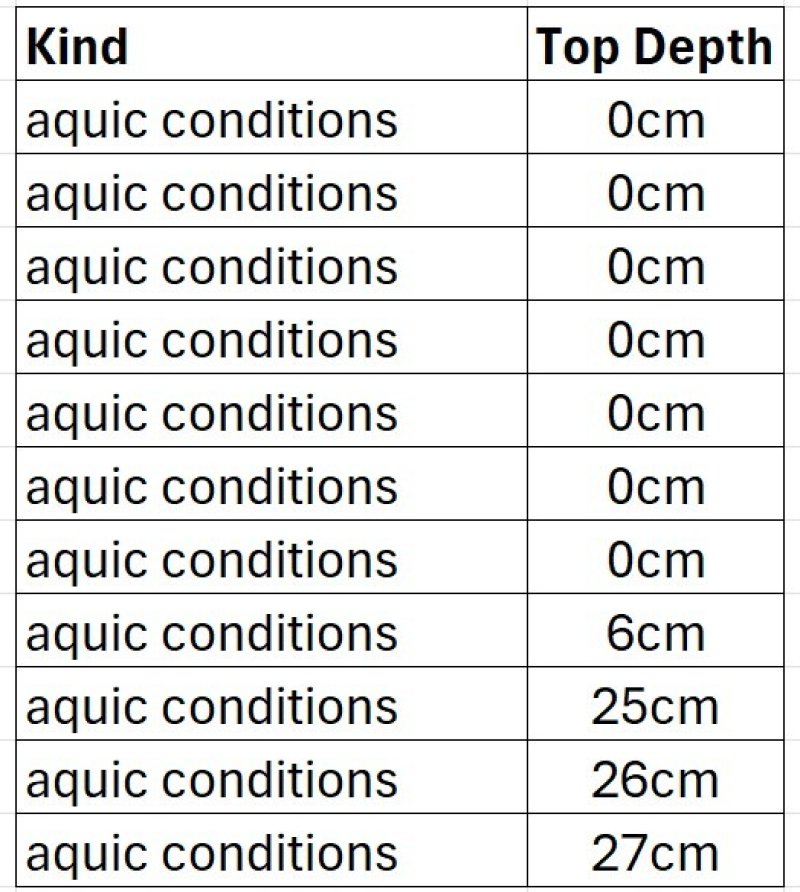
Figure 6. Depth to seasonal water table at 11 sampled sites.
Soil features
The soils of the Wet Meadow ecological site are primarily comprised of Mollisols that contain organic material at or near the surface. The soils of this site have a seasonal water table depth of zero to 30cm (zero to 12 inches), meaning that the soils are inundated for periods long enough for redoximorphic features to occur. These soils have a cryic temperature regime and an aquic moisture regime.
Representative taxonomy includes:
Loamy-skeletal, mixed, superactive Typic Cryaquents
Coarse-loamy, mixed, superactive Cumulic Cryaquolls
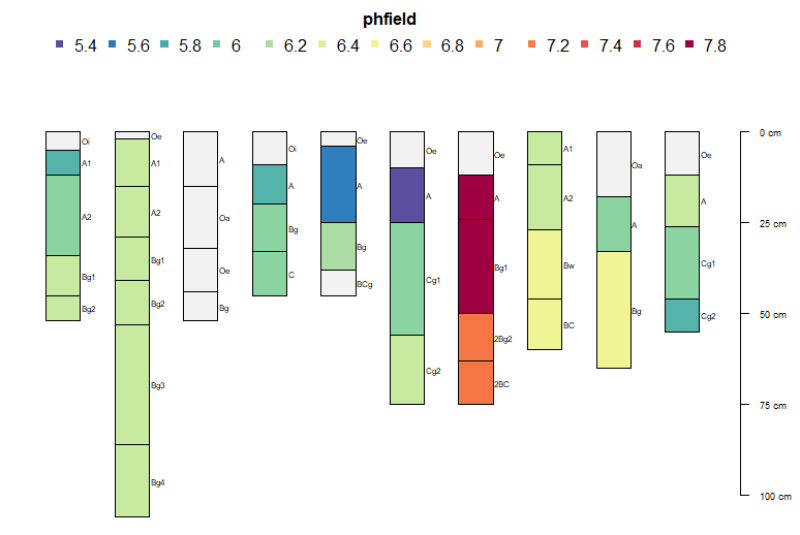
Figure 7. pH by horizon of ten sampled Wet Meadow sites.
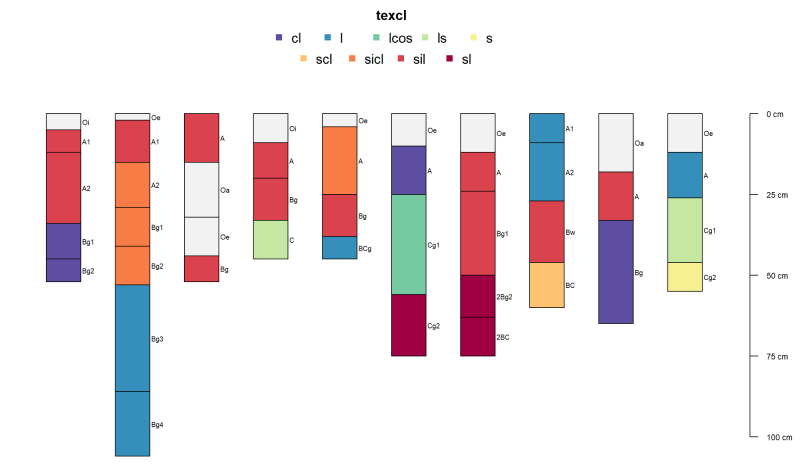
Figure 8. Texture class by horizon of ten sampled Wet Meadow sites.
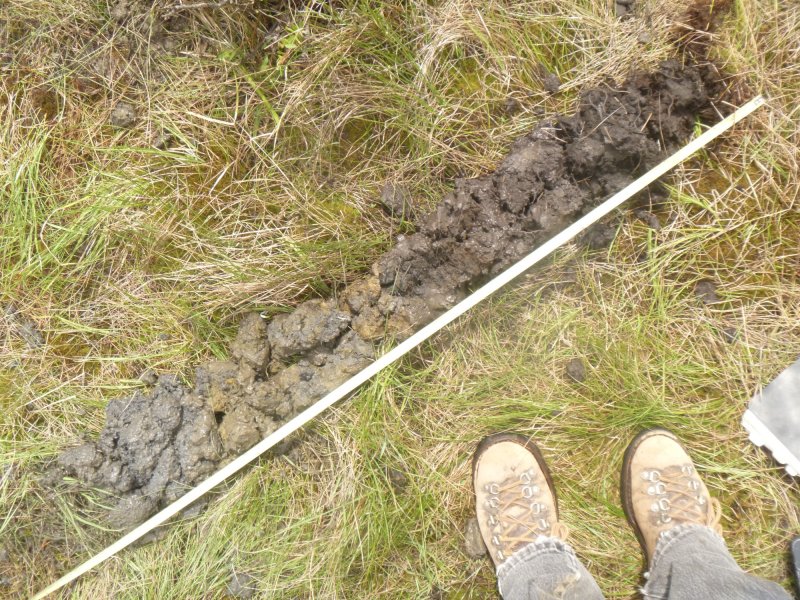
Figure 9.
Table 5. Representative soil features
| Parent material |
(1)
Alluvium
(2) Slope alluvium |
|---|---|
| Surface texture |
(1) Loam (2) Silt loam (3) Mucky peat (4) Muck (5) Peat |
| Drainage class | Poorly drained to very poorly drained |
| Permeability class | Moderate to moderately rapid |
| Soil depth | 40 – 60 in |
| Surface fragment cover <=3" | 1% |
| Surface fragment cover >3" | 1% |
| Available water capacity (0-20in) |
4.3 – 4.5 in |
| Soil reaction (1:1 water) (0-20in) |
6.6 – 7.4 |
| Subsurface fragment volume <=3" (0-20in) |
5% |
| Subsurface fragment volume >3" (0-20in) |
3% |
Table 6. Representative soil features (actual values)
| Drainage class | Not specified |
|---|---|
| Permeability class | Not specified |
| Soil depth | Not specified |
| Surface fragment cover <=3" | Not specified |
| Surface fragment cover >3" | Not specified |
| Available water capacity (0-20in) |
4.2 – 4.6 in |
| Soil reaction (1:1 water) (0-20in) |
4.5 – 7.8 |
| Subsurface fragment volume <=3" (0-20in) |
Not specified |
| Subsurface fragment volume >3" (0-20in) |
Not specified |
Ecological dynamics
The Wet Meadow ecological site is a rangeland ecological site existing within the greater meadow and groundwater-dependent ecosystem groups. Grasses and sedges dominate plant composition in the Reference state, with willow and other shrub species being subdominant. Fluctuations in available moisture via depth to the seasonal groundwater table can impact plant composition, canopy cover, and production. Depth to the seasonal water table tends to increase as distance increases from the water source. When this depth exceeds 12 inches (30cm), transition to a new ecological site occurs.
Transitions from the reference state are driven by disturbances both natural and anthropogenic. The two primary disturbances likely to impact this ecological site are herbivory and anthropogenic land changes that alter the hydrology. To a lesser extent, climate-driven disturbances such as drought can also instigate transitions within the site's range of variability.
A state-and-transition model (STM) diagram for this ecological site is depicted in this section. Thorough descriptions of each state, transition, plant community phase, and pathway are found after the state-and-transition model. This STM is based on available experimental research, field observations, professional consensus, and interpretations. While based on the best available information, the STM will change over time as knowledge of ecological processes increases.
Plant community composition within this ecological site has a natural range of variability across the LRU due to the natural variability in weather, soils, and aspect. The reference plant community may not fit management goals. Selection of other plant communities is valid if the identified range health attributes have none to slight or slight departures from the Reference State. The biological processes on this site are complex; therefore, representative values are presented in a land management context. The species lists are representative and are not botanical descriptions of all species potentially occurring on this site. They are not intended to cover every situation or the full range of conditions, species, and responses for the ecological site.
Both percent species composition by weight and percent cover are used in this ecological site description. Foliar cover is used to define plant community phases and states in the STM. Cover drives the transitions between communities and states because of the influence of shade and interception of rainfall.
Species composition by dry weight remains an important descriptor of the herbaceous community and of site productivity as a whole and includes both herbaceous and woody species. Calculating the similarity index requires data on species composition by dry weight.
Although there is considerable qualitative experience supporting the pathways and transitions within the state-and-transition model, no quantitative information exists that specifically identifies threshold parameters between reference states and degraded states in this ecological site.
State and transition model
More interactive model formats are also available.
View Interactive Models
Click on state and transition labels to scroll to the respective text
Ecosystem states
State 1 submodel, plant communities
State 2 submodel, plant communities
State 3 submodel, plant communities
State 1
Reference
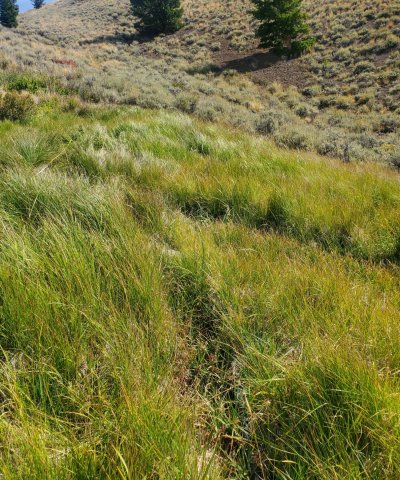
Figure 10. Reference State
The Reference state consists of two dominant plant communities: A sedge and bunchgrass-dominated community and a shrub and sedge co-dominated community. The sedges and grasses in Community 1.1 can vary in composition and canopy cover but are highly productive and sedges tend to occupy a greater portion of the canopy than rhizomatous and bunchgrass species. In the shrub and sedge co-dominated community, willow (Salix) species are the primary shrub species but can include various species of currant, rose, cinquefoil, and others. Processes (both natural and anthropogenic) that result in state and community changes include fire, grazing, land use change, and the occurrence of invasive species.
Characteristics and indicators. The Reference state is characterized by a plant composition of almost entirely native plants (less than five percent canopy cover of non-native species) that are highly productive with a dense canopy cover. Overstory vegetative cover ranges from 90 to 100 percent with less than three percent exposed bare ground. Production values in the Reference state range from 2,500 to 4,000 pounds per acre.
Resilience management. Resilience in the Reference state is high due to the aquic moisture regime and intact native plant communities. The additional water available via groundwater in a seasonal water table aids in resistance to drought as well as susceptibility to wildfire. The intact native plant communities provide a dense foliar cover with high amounts of surface litter and soil organic material that decreases susceptibility to erosion. Canopy cover of native vegetation decreases the ability for non-native, invasive species to establish.
Dominant plant species
-
willow (Salix), shrub
-
shrubby cinquefoil (Dasiphora fruticosa), shrub
-
sedge (Carex), grass
-
rush (Juncus), grass
-
hairgrass (Deschampsia), grass
-
alpine leafybract aster (Symphyotrichum foliaceum), other herbaceous
-
cinquefoil (Potentilla), other herbaceous
-
common yarrow (Achillea millefolium), other herbaceous
Community 1.1
Sedge and Bunchgrass

Figure 11. Community 1.1
The Sedge and Bunchgrass community (Community 1.1) of the Reference state is well adapted to the climatic conditions and the presence of a seasonal water table at this ecological site. Most of the primary sedges and grasses can thrive under favorable moisture conditions and are highly productive. This community can occur over the entire ecological site or as a mosaic with Community 1.2 (Shrub and Sedge community). The plants present in this state and community are highly reliant on a functioning hydrologic system, and plant composition can change rapidly when that system is interrupted. At the edges of this ecological site where the seasonal water table begins to drop deeper into the soil profile and additional water is not as accessible to plants, composition shifts to species better adapted to drier upland conditions. A mix of sedges dominates this site with the greatest canopy cover being attributed to Nebraska sedge (Carex nebrascensis) or water sedge (Carex aquatilis). Combined grass and sedge canopy cover cover ranges from 60 to 80 percent. Shrub species, primarily willows (Salix spp.), currant (Ribes spp.), and shrubby cinquefoil (Dasiphora fruticosa) account for up to five to 15 percent of the canopy cover, and assorted forbs account for three to eight percent. Total vegetative canopy cover is 90 to 100 percent with bare ground ranging from zero to three percent. Litter is present on greater than 75 percent of soil surface. Total combined cover (canopy and foliar) ranges from 175 to 300 percent. Total annual production (measured as dry weight) is between 1,700 and 3,500 pounds per acre.
Resilience management. The Sedge and Bunchgrass community has moderate resilience. This site is resistant to the effects of drought due to the additional groundwater present. The additional moisture and plant composition also make this site resistant to wildfire. This community has low resilience towards intense livestock grazing. Chronic defoliation changes plant composition and total functional group canopy cover. As a result of compositional and canopy cover changes, total annual production decreases. Long-duration, intensive grazing also leads to hummocks and pedestals due to hoof impact. Openings in the canopy and surface increase the recruitment of invasive and unwanted plant species. This community is very sensitive to changes in the hydrologic regime as the community relies heavily on additional moisture through groundwater.
Dominant plant species
-
Nebraska sedge (Carex nebrascensis), grass
-
mountain rush (Juncus arcticus ssp. littoralis), grass
-
tufted hairgrass (Deschampsia cespitosa), grass
-
slender cinquefoil (Potentilla gracilis), other herbaceous
-
alpine leafybract aster (Symphyotrichum foliaceum), other herbaceous
Figure 12. Annual production by plant type (representative values) or group (midpoint values)
Table 7. Annual production by plant type
| Plant type | Low (lb/acre) |
Representative value (lb/acre) |
High (lb/acre) |
|---|---|---|---|
| Grass/Grasslike | 1500 | 2200 | 2900 |
| Shrub/Vine | 0 | 300 | 475 |
| Forb | 100 | 150 | 175 |
| Total | 1600 | 2650 | 3550 |
Table 8. Ground cover
| Tree foliar cover | 0% |
|---|---|
| Shrub/vine/liana foliar cover | 5-15% |
| Grass/grasslike foliar cover | 60-80% |
| Forb foliar cover | 3-8% |
| Non-vascular plants | 0% |
| Biological crusts | 0% |
| Litter | 75-95% |
| Surface fragments >0.25" and <=3" | 0-2% |
| Surface fragments >3" | 0% |
| Bedrock | 0% |
| Water | 0-10% |
| Bare ground | 0-3% |
Table 9. Soil surface cover
| Tree basal cover | 0% |
|---|---|
| Shrub/vine/liana basal cover | 0-2% |
| Grass/grasslike basal cover | 2-8% |
| Forb basal cover | 0-2% |
| Non-vascular plants | 0% |
| Biological crusts | 0% |
| Litter | 0% |
| Surface fragments >0.25" and <=3" | 0-2% |
| Surface fragments >3" | 0% |
| Bedrock | 0% |
| Water | 0-10% |
| Bare ground | 0-3% |
Figure 13. Plant community growth curve (percent production by month). ID0214, Wet Meadow. State 1.
| Jan | Feb | Mar | Apr | May | Jun | Jul | Aug | Sep | Oct | Nov | Dec |
|---|---|---|---|---|---|---|---|---|---|---|---|
| J | F | M | A | M | J | J | A | S | O | N | D |
| 0 | 0 | 0 | 5 | 20 | 20 | 35 | 20 | 0 | 0 | 0 | 0 |
Community 1.2
Shrub and Sedge

Figure 14. Community 1.2
The Shrub and Sedge community (1.2) of the Reference state differs from Community 1.1 primarily through an increase in shrub canopy cover. This increase is most prevalent through willow species (Salix spp.) and shrubby cinquefoil. Along with the increase in shrub canopy cover, there is a decrease in canopy cover of many of the primary sedges and grasses seen in Community 1.1. Like Community 1.1, 1.2 is well adapted to the climate and hydrologic conditions present at this ecological site. This community can occur over the entire ecological site or as a mosaic with Community 1.1 (Sedge and Bunchgrass community). The plants found in this community are highly dependent on a functioning hydrologic system and the presence of seasonal groundwater. At the edge of the ecological site where seasonal water tables are deeper in the soil profile, plant composition and canopy cover shift towards plants that are better adapted to drier, upland conditions. Community 1.2 is still dominated by grasses and sedges, however shrub canopy cover reaches over 15 percent. The primary grasses and sedges are Nebraska sedge and water sedge, tufted hairgrass (Deschampsia cespitosa), and mountain rush (Juncus arcticus ssp littoralis). Canopy cover from grasses and sedges ranges from 55 to 75 percent. Shrub canopy cover is 15 to 30 percent, and forb canopy cover exists at three to eight percent. The total canopy cover ranges from 90 to 100 percent with bare ground comprising zero (0) to three (3) percent. Litter is present on greater than 75 percent of the soil surface. Total combined cover (canopy and foliar) is 175 to 300 percent. Production in this community is similar to that of Community 1.1 ranging from 1,600 to 3,400 pounds per acre, however, a greater portion of that production is shifted into the shrub functional group.
Resilience management. The Shrub and Sedge community has moderate resilience. This site is resistant to the effects of drought due to the additional groundwater present. The additional moisture and plant composition also make this site resistant to wildfire. This community has low resilience towards intense livestock grazing. Chronic defoliation changes plant composition and total and functional group canopy cover. As a result of compositional and canopy cover changes, total annual production decreases. Long-duration, intensive grazing also leads to hummocks and pedestals due to hoof impact. Openings in the canopy and surface increase the recruitment of invasive and unwanted plant species. This community is very sensitive to changes in the hydrologic regime due to the community's heavy reliance on additional moisture through groundwater.
Dominant plant species
-
Geyer willow (Salix geyeriana), shrub
-
Wolf's willow (Salix wolfii), shrub
-
shrubby cinquefoil (Dasiphora fruticosa), shrub
-
Nebraska sedge (Carex nebrascensis), grass
-
mountain rush (Juncus arcticus ssp. littoralis), grass
-
tufted hairgrass (Deschampsia cespitosa), grass
-
slender cinquefoil (Potentilla gracilis), other herbaceous
-
alpine leafybract aster (Symphyotrichum foliaceum), other herbaceous
Figure 15. Annual production by plant type (representative values) or group (midpoint values)
Table 10. Annual production by plant type
| Plant type | Low (lb/acre) |
Representative value (lb/acre) |
High (lb/acre) |
|---|---|---|---|
| Grass/Grasslike | 1400 | 2000 | 2500 |
| Shrub/Vine | 300 | 550 | 750 |
| Forb | 50 | 125 | 200 |
| Total | 1750 | 2675 | 3450 |
Table 11. Ground cover
| Tree foliar cover | 0% |
|---|---|
| Shrub/vine/liana foliar cover | 10-30% |
| Grass/grasslike foliar cover | 45-70% |
| Forb foliar cover | 3-8% |
| Non-vascular plants | 0% |
| Biological crusts | 0% |
| Litter | 70-90% |
| Surface fragments >0.25" and <=3" | 0-2% |
| Surface fragments >3" | 0% |
| Bedrock | 0% |
| Water | 0-10% |
| Bare ground | 0-3% |
Table 12. Soil surface cover
| Tree basal cover | 0% |
|---|---|
| Shrub/vine/liana basal cover | 1-3% |
| Grass/grasslike basal cover | 2-8% |
| Forb basal cover | 0-2% |
| Non-vascular plants | 0% |
| Biological crusts | 0% |
| Litter | 0% |
| Surface fragments >0.25" and <=3" | 0-2% |
| Surface fragments >3" | 0% |
| Bedrock | 0% |
| Water | 0-10% |
| Bare ground | 0-3% |
Figure 16. Plant community growth curve (percent production by month). ID0915, Wet Meadow.
| Jan | Feb | Mar | Apr | May | Jun | Jul | Aug | Sep | Oct | Nov | Dec |
|---|---|---|---|---|---|---|---|---|---|---|---|
| J | F | M | A | M | J | J | A | S | O | N | D |
| 0 | 0 | 0 | 5 | 20 | 20 | 25 | 20 | 10 | 0 | 0 | 0 |
Pathway 1.1A
Community 1.1 to 1.2


The transition from the Sedge and Bunchgrass community to the Shrub and Sedge community is primarily a product of succession and time without a shrub-removing disturbance. Willow species can colonize and gradually increase in canopy cover over time in the absence of a shrub-removing disturbance like fire. Shrubby cinquefoil and certain willow species can act as pioneer species on recently disturbed sites (floods, recently formed riparian channels) and continued disturbance can increase canopy cover (Anderson, 2001; Esser, 1992).
Pathway 1.2A
Community 1.2 to 1.1


The transition from the Shrub and Sedge community to the Sedge and Bunchgrass community is a product of a shrub-removing disturbance. Fire is the primary shrub-removing disturbance to occur a these sites and the loss of shrub canopy cover will be replaced by plants in the grass and forb functional group.
Context dependence. Only severe fire events will initiate the transition to the Sedge and Bunchgrass community. If the fire is low to moderate severity, it may increase shrub canopy cover as many willow species re-sprout vigorously from the root crown or basal stem (Esser, 1992).
State 2
Grazing Sustained
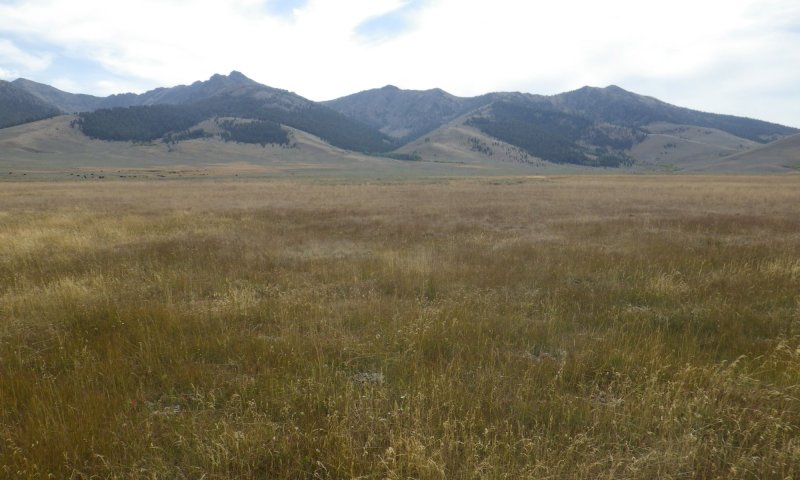
The Grazing Sustained state of the Wet Meadow ecological site occurs when agricultural grazing does not result in chronic defoliation or creation of pedestals, allowing for the recovery of most Reference state plants each growing season. In the Grazing Sustained state, annual production values decrease from that of the Reference state as a result of yearly defoliation. Canopy cover of native forb species increases as a result of canopy defoliation of more desirable grass and sedge species. Non-native species canopy cover will increase slightly, but remain under five percent in most circumstances. This state does not exhibit hummocks or pedestals due to high-intensity hoof traffic from grazing pressure.
Characteristics and indicators. The Grazing Sustained state of the Wet Meadow ecological site is similar to the Reference state in canopy cover and plant composition. The primary characteristic of this state is a reduction in total annual production and a slight shift in plant composition towards more grazing-tolerant grasses and a higher canopy cover of forbs. Invasive species canopy cover remains under five percent, though species like Kentucky bluegrass (Poa pratensis) and common dandelion (Taraxacum officinale) may exceed five percent canopy cover.
Resilience management. Resilience in the Grazing Sustained state is lower than the Reference state but remains moderate. In this state, hydrologic regimes remain intact and plant composition closely resembles that of the Reference state. Defoliation from chronic grazing results in canopy openings that increase the risk of invasive species recruitment as well as decrease resilience to drought. Soil organic matter and surface litter remain intact decreasing the risk of soil erosion.
Dominant plant species
-
Geyer willow (Salix geyeriana), shrub
-
Wolf's willow (Salix wolfii), shrub
-
shrubby cinquefoil (Dasiphora fruticosa), shrub
-
Nebraska sedge (Carex nebrascensis), grass
-
smallwing sedge (Carex microptera), grass
-
Northwest Territory sedge (Carex utriculata), grass
-
tufted hairgrass (Deschampsia cespitosa), grass
-
bentgrass (Agrostis), grass
-
slender cinquefoil (Potentilla gracilis), other herbaceous
-
alpine leafybract aster (Symphyotrichum foliaceum), other herbaceous
-
common yarrow (Achillea millefolium), other herbaceous
Community 2.1
Grazed Mixed Grass
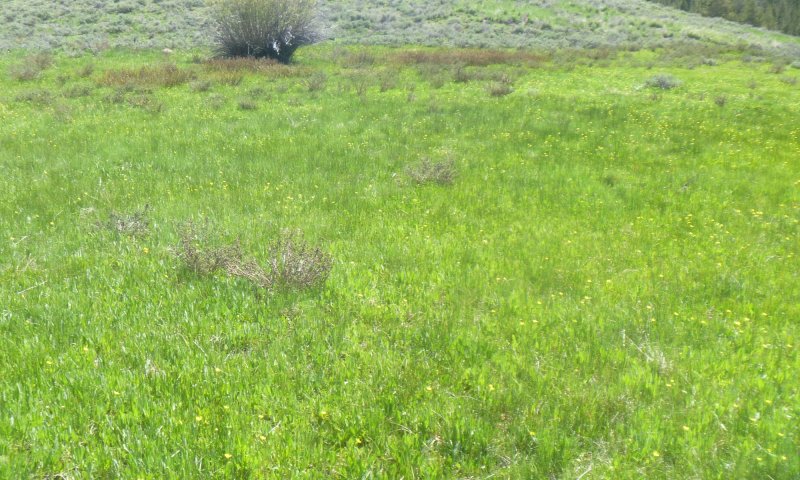
Figure 17. Community 2.1
The Grazed Mixed Grass community (community 2.1) of the Grazing Sustained state is highly reliant on additional moisture through seasonal groundwater. The primary sedges, rushes, and grasses that dominate the canopy in this community thrive when groundwater is at or near the surface during the spring and into the growing season. At the edges of this ecological site where the seasonal water table begins to drop deeper into the soil profile and additional water is not as accessible to plants, composition shifts to species better adapted to drier upland conditions. This community can occur over the entire ecological site or exist in a mosaic with community 2.2. The communities in this state experience light to moderate seasonal grazing pressure. At this level, the hydrologic regime is not interrupted and defoliation does not occur to the extent that a significant shift in plant composition or canopy cover will occur. This community will have slightly lower annual production values than the communities of the Reference state, but will mostly recover year to year. The Grazed Mixed Grass community is dominated by Nebraska sedge, water sedge (or a mix of the two), mountain rush, and tufted hairgrass. Forb canopy cover remains minimal and is mostly restricted to the foliar canopy. Shrub canopy may or may not be present, but remains under 15 percent. Combined grass and sedge canopy cover ranges from 53 to 70 percent. Forb canopy cover is between three (3) to 11 percent. Total vegetative cover in this community (canopy and foliar) ranges from 95 to 150 percent and production ranges from 1,100 to 2,600 pounds per acre. Bare ground without canopy cover increases from that of the Reference state and falls within a range of zero (0) to eight (8) percent.
Resilience management. Community 2.1 has moderate resilience. Defoliation from seasonal grazing increases the opportunity for invasive species recruitment and openings in the canopy can transition from grass cover to forb cover. The increase in bare ground cover makes the community more susceptible to erosion and presents greater opportunities for invasive species recruitment. As long as the hydrologic system is functioning, resistance to drought is high.
Dominant plant species
-
Nebraska sedge (Carex nebrascensis), grass
-
mountain rush (Juncus arcticus ssp. littoralis), grass
-
tufted hairgrass (Deschampsia cespitosa), grass
-
slender cinquefoil (Potentilla gracilis), other herbaceous
-
alpine leafybract aster (Symphyotrichum foliaceum), other herbaceous
Figure 18. Annual production by plant type (representative values) or group (midpoint values)
Table 13. Annual production by plant type
| Plant type | Low (lb/acre) |
Representative value (lb/acre) |
High (lb/acre) |
|---|---|---|---|
| Grass/Grasslike | 500 | 850 | 1300 |
| Shrub/Vine | 0 | 125 | 300 |
| Forb | 125 | 165 | 225 |
| Total | 625 | 1140 | 1825 |
Table 14. Ground cover
| Tree foliar cover | 0% |
|---|---|
| Shrub/vine/liana foliar cover | 0-15% |
| Grass/grasslike foliar cover | 53-70% |
| Forb foliar cover | 3-11% |
| Non-vascular plants | 3-15% |
| Biological crusts | 0% |
| Litter | 5-17% |
| Surface fragments >0.25" and <=3" | 0-3% |
| Surface fragments >3" | 0% |
| Bedrock | 0% |
| Water | 0-10% |
| Bare ground | 0-8% |
Table 15. Soil surface cover
| Tree basal cover | 0% |
|---|---|
| Shrub/vine/liana basal cover | 0-3% |
| Grass/grasslike basal cover | 2-7% |
| Forb basal cover | 1-3% |
| Non-vascular plants | 30-60% |
| Biological crusts | 0% |
| Litter | 0% |
| Surface fragments >0.25" and <=3" | 0-3% |
| Surface fragments >3" | 0% |
| Bedrock | 0% |
| Water | 0-10% |
| Bare ground | 50-80% |
Figure 19. Plant community growth curve (percent production by month). ID0214, Wet Meadow. State 1.
| Jan | Feb | Mar | Apr | May | Jun | Jul | Aug | Sep | Oct | Nov | Dec |
|---|---|---|---|---|---|---|---|---|---|---|---|
| J | F | M | A | M | J | J | A | S | O | N | D |
| 0 | 0 | 0 | 5 | 20 | 20 | 35 | 20 | 0 | 0 | 0 | 0 |
Community 2.2
Shrub and Mixed Grass
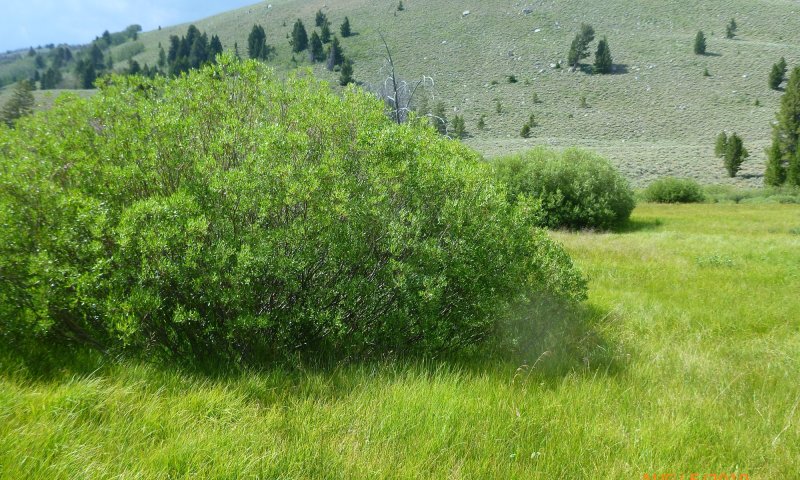
Figure 20. Community 2.2
The Shrub and Mixed Grass community of the Grazing Sustained site is indicated by a shrub canopy cover of over 15 percent. Overall composition is similar to that of Community 1.2 in the Reference state, however, forb canopy cover increases and average annual production decreases as a result of yearly grazing pressure. The primary shrub species found in this community include shrubby cinquefoil and a variety of willow species including wolf willow, Geyer's willow (Salix geyeriana) and Booth's willow (Salix boothii). This community is highly reliant on a functioning hydrologic regime and the presence of a seasonal groundwater table within 12 inches (30cm) of the soil surface. Like community 2.1, grazing pressure is managed such that no pedestals or hummocks form and depth to seasonal groundwater remains homogenous across the ecological site. Shrub canopy cover in this community can occupy more than half of the ecological site, ranging from 15 to 65 percent. Shrub canopy cover can be continuous or can exist in a mosaic with the Grazed Mixed Grass community (2.1). Grass and sedge canopy cover varies from 30 to 60 percent and forb canopy cover remains at three (3) to 11 percent. Total annual production is slightly lower than Community 2.1 with more shrubs occupying the canopy and ranges from 1,100 to 2,300 pounds per acre.
Resilience management. Community 2.2 has moderate resilience. The seasonal groundwater table aids in resistance to drought. Many of the willow species found at this site are fire-tolerant species with a short postfire regeneration period following a fire event, however, a severe enough fire can be stand replacing and allow herbaceous species to establish in their place. Shrubby cinquefoil is a disturbance-tolerant species and can increase under a repetitive disturbance regime. The light to moderate grazing pressure that occurs in this community can create openings in the canopy and expose bare ground, increasing vulnerability to invasive species recruitment. Shifts in canopy composition to more grazing-tolerant species and annual forbs can also increase vulnerability to the establishment of undesirable species.
Dominant plant species
-
shrubby cinquefoil (Dasiphora fruticosa), shrub
-
willow (Salix), shrub
-
Nebraska sedge (Carex nebrascensis), grass
-
mountain rush (Juncus arcticus ssp. littoralis), grass
-
tufted hairgrass (Deschampsia cespitosa), grass
-
slender cinquefoil (Potentilla gracilis), other herbaceous
-
alpine leafybract aster (Symphyotrichum foliaceum), other herbaceous
Figure 21. Annual production by plant type (representative values) or group (midpoint values)
Table 16. Annual production by plant type
| Plant type | Low (lb/acre) |
Representative value (lb/acre) |
High (lb/acre) |
|---|---|---|---|
| Grass/Grasslike | 600 | 800 | 1200 |
| Shrub/Vine | 375 | 500 | 850 |
| Forb | 125 | 200 | 300 |
| Total | 1100 | 1500 | 2350 |
Table 17. Ground cover
| Tree foliar cover | 0% |
|---|---|
| Shrub/vine/liana foliar cover | 15-65% |
| Grass/grasslike foliar cover | 40-65% |
| Forb foliar cover | 3-11% |
| Non-vascular plants | 0-3% |
| Biological crusts | 0% |
| Litter | 0-5% |
| Surface fragments >0.25" and <=3" | 0-3% |
| Surface fragments >3" | 0% |
| Bedrock | 0% |
| Water | 0-10% |
| Bare ground | 0-8% |
Table 18. Soil surface cover
| Tree basal cover | 0% |
|---|---|
| Shrub/vine/liana basal cover | 2-5% |
| Grass/grasslike basal cover | 2-7% |
| Forb basal cover | 1-3% |
| Non-vascular plants | 0-10% |
| Biological crusts | 0% |
| Litter | 0% |
| Surface fragments >0.25" and <=3" | 0-3% |
| Surface fragments >3" | 0% |
| Bedrock | 0% |
| Water | 0-10% |
| Bare ground | 55-85% |
Figure 22. Plant community growth curve (percent production by month). ID0214, Wet Meadow. State 1.
| Jan | Feb | Mar | Apr | May | Jun | Jul | Aug | Sep | Oct | Nov | Dec |
|---|---|---|---|---|---|---|---|---|---|---|---|
| J | F | M | A | M | J | J | A | S | O | N | D |
| 0 | 0 | 0 | 5 | 20 | 20 | 35 | 20 | 0 | 0 | 0 | 0 |
Pathway 2.1A
Community 2.1 to 2.2


The transition from the Grazed Mixed Grass community to the Shrub and Grass community is primarily a product of succession and time without a shrub-removing disturbance. Willow species can colonize and gradually increase in canopy cover over time in the absence of a shrub-removing disturbance like fire. Shrubby cinquefoil and certain willow species can act as pioneer species on recently disturbed sites (floods, recently formed riparian channels) and continued disturbance can increase canopy cover (Anderson, 2001; Esser, 1992).
Context dependence. Shrubby cinquefoil is the primary shrub species on this ecological site to increase canopy cover through low to moderate severity disturbance. Interruptions to site hydrology or consistent moderate-intensity grazing can facilitate the dominance of the species over time.
Pathway 2.2A
Community 2.2 to 2.1


The transition from the Shrub and Mixed Grass community to the Grazed Mixed Grass community is a product of a shrub-removing disturbance. Fire is the primary shrub-removing disturbance to occur a these sites and the loss of shrub canopy cover will be replaced by plants in the grass and forb functional group.
Context dependence. Only severe fire events will initiate the transition to the Grazed Mixed Grass community. If the fire is low to moderate severity, it may increase shrub canopy cover as many willow species re-sprout vigorously from the root crown or basal stem (Esser, 1992).
State 3
Degraded
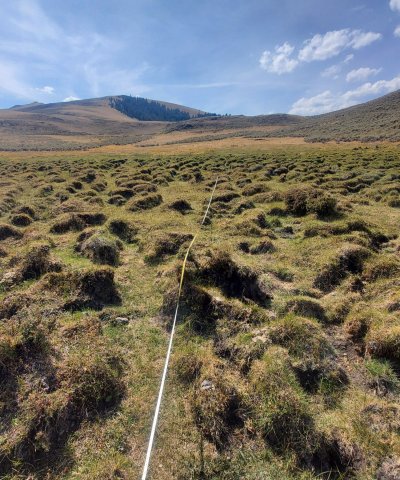
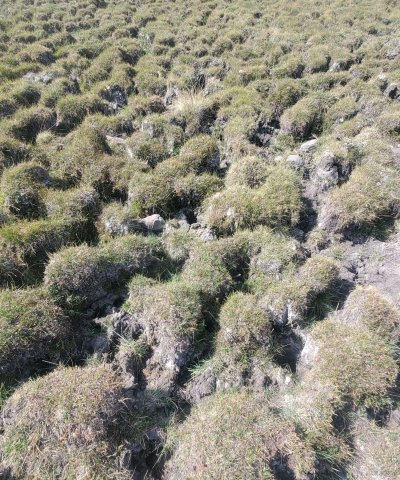
The Degraded state occurs when a disturbance disrupts the hydrologic regime for the site and a significant shift in plant composition and canopy cover occurs. The primary disturbance that causes a shift to the degraded state is high-intensity hoof traffic and chronic defoliation as a result of long-duration, intensive grazing practices. Other disturbances include mechanical land manipulation and severe erosion. High-intensity hoof traffic from grazing animals during the wetter periods of the season can result in severe pedestaling. Severe pedestaling creates large fluctuations in depth to available groundwater, leaving the tops of pedestals occupied by upland plants that can tolerate less available moisture. Openings in the canopy previously occupied by sedges and grasses are replaced by disturbance-tolerant forbs and the amount of bare ground increases significantly.
Characteristics and indicators. The primary indicators of the degraded state include a shift in plant composition to drier, upland vegetation and the presence of severe pedestaling of soil. When pedestals form, depth to groundwater varies across the ecological site creating opportunities for vegetation requiring less moisture to establish. A significant increase in forb canopy cover will occur as chronic defoliation of grass overstory creates openings in the canopy. Bare ground increases significantly in this state and non-native plant cover increases. Production is moderated as a result of hydrologic conditions and chronic defoliation, ranging from 750 to 1800 pounds per acre.
Resilience management. Resilience in the Degraded state is lower than in all other states because the site's hydrology has been modified and hydrologic regimes are no longer intact. Resistance to invasion from non-natives and annual grasses decreases with the loss of a properly functioning hydrologic system. Chronic defoliation and increased bare ground also decrease resistance to the invasion of non-native and undesirable species.
Dominant plant species
-
shrubby cinquefoil (Dasiphora fruticosa), shrub
Community 3.1
Shrubby Cinquefoil and Mixed Forb
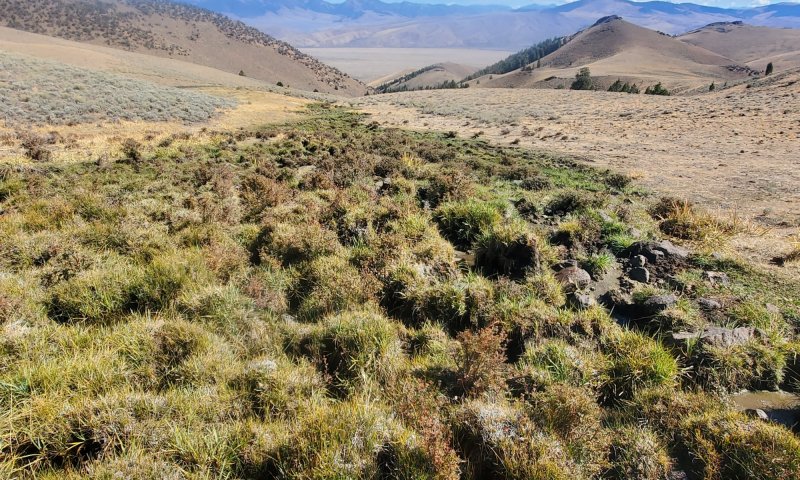
Figure 23. Community 3.1
The Shrubby Cinquefoil and Mixed Forb community of the Degraded state (Community 3.1) is indicated by a 15 percent or greater canopy cover of shrubby cinquefoil at a given site. Shrubby cinquefoil is drought tolerant and often occupies transitional areas from groundwater-dependent ecosystems to upland ecosystems. The species can take advantage of canopy openings created through the removal or reduction of Reference state grasses and colonizes disturbed sites well. Continued disturbance can lead to a gradual increase in the canopy cover of the shrub (Anderson, 2001). Like Community 3.2, this community will have a higher canopy cover of forb species than the communities of the Reference state. This is especially true for disturbance-tolerant species such as Rocky Mountain iris (Iris missouriensis). An increase in non-native species such as common dandelion, clover (Trifolium spp.) and Kentucky bluegrass occurs in this community.
Resilience management. The Shrubby cinquefoil/Mixed Forb community has moderate resilience. Many of the plants that begin to occupy more of the total canopy cover in this community are much more drought-tolerant species. This community also becomes more tolerant to intensive grazing as more grazing-tolerant species replace those of the Reference state. This community loses resilience to the invasion of non-native species due to a lack of function in the hydrologic system, chronic defoliation from grazing and subsequent openings in the canopy.
Dominant plant species
-
shrubby cinquefoil (Dasiphora fruticosa), shrub
-
Nebraska sedge (Carex nebrascensis), grass
-
mountain rush (Juncus arcticus ssp. littoralis), grass
-
common yarrow (Achillea millefolium), other herbaceous
-
slender cinquefoil (Potentilla gracilis), other herbaceous
Figure 24. Annual production by plant type (representative values) or group (midpoint values)
Table 19. Annual production by plant type
| Plant type | Low (lb/acre) |
Representative value (lb/acre) |
High (lb/acre) |
|---|---|---|---|
| Grass/Grasslike | 450 | 800 | 1000 |
| Shrub/Vine | 175 | 350 | 750 |
| Forb | 75 | 150 | 250 |
| Total | 700 | 1300 | 2000 |
Table 20. Ground cover
| Tree foliar cover | 0% |
|---|---|
| Shrub/vine/liana foliar cover | 15-35% |
| Grass/grasslike foliar cover | 30-65% |
| Forb foliar cover | 6-17% |
| Non-vascular plants | 0-5% |
| Biological crusts | 0% |
| Litter | 0-5% |
| Surface fragments >0.25" and <=3" | 0-3% |
| Surface fragments >3" | 0% |
| Bedrock | 0% |
| Water | 0-5% |
| Bare ground | 10-27% |
Table 21. Soil surface cover
| Tree basal cover | 0% |
|---|---|
| Shrub/vine/liana basal cover | 1-4% |
| Grass/grasslike basal cover | 2-6% |
| Forb basal cover | 0-3% |
| Non-vascular plants | 2-10% |
| Biological crusts | 0% |
| Litter | 0% |
| Surface fragments >0.25" and <=3" | 0-5% |
| Surface fragments >3" | 0% |
| Bedrock | 0% |
| Water | 0-5% |
| Bare ground | 72-90% |
Figure 25. Plant community growth curve (percent production by month). ID0314, Wet Meadow. State 1, Reference Plant Community Phase.
| Jan | Feb | Mar | Apr | May | Jun | Jul | Aug | Sep | Oct | Nov | Dec |
|---|---|---|---|---|---|---|---|---|---|---|---|
| J | F | M | A | M | J | J | A | S | O | N | D |
| 0 | 0 | 0 | 5 | 15 | 20 | 30 | 20 | 10 | 0 | 0 | 0 |
Community 3.2
Forb and Mixed Grass
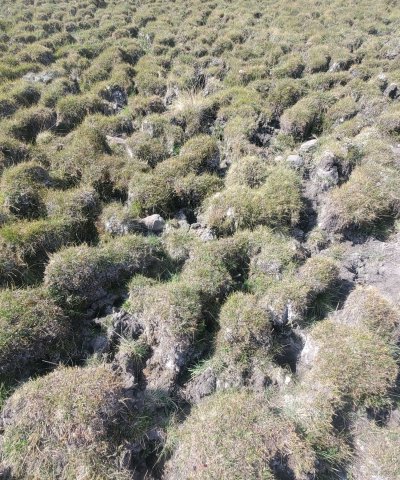
Figure 26. Community 3.2
The Forb and Mixed Grass community of the Degraded state (Community 3.2) is identified by a significant shift in plant composition and canopy cover from that of the Reference state communities. Pedastaling/hummocks present at sites in this state and community create major fluctuations in depth to the water table. This drives a transition to species that are more drought-tolerant and better adapted to upland conditions. Species that tolerate disturbance and high grazing pressure such as Rocky Mountain iris, common dandelion, Kentucky bluegrass, meadow barley (Hordeum brachyantherum), and slender cinquefoil (Potentilla gracilis) will also increase in canopy cover, replacing many of the species in the Reference state communities. Chronic defoliation resulting from long duration, high-intensity grazing and changes to the hydrologic regime account for a shift in functional group canopy cover. Grass and grass-like species present in the Reference state communities decrease in overstory and total canopy cover, while forbs increase.
Resilience management. The Forb and Mixed Grass community community has moderate resilience. Many of the plants that begin to occupy more of the total canopy cover in this community are much more drought-tolerant species. This community also becomes more tolerant to intensive grazing as more grazing-tolerant species replace those of the Reference state. This community loses resilience to the invasion of non-native species due to a lack of function in the hydrologic system, chronic defoliation from grazing and subsequent openings in the canopy.
Dominant plant species
-
Kentucky bluegrass (Poa pratensis), grass
-
Douglas' sedge (Carex douglasii), grass
-
meadow barley (Hordeum brachyantherum), grass
-
slender cinquefoil (Potentilla gracilis), other herbaceous
-
fleabane (Erigeron), other herbaceous
-
common yarrow (Achillea millefolium), other herbaceous
Figure 27. Annual production by plant type (representative values) or group (midpoint values)
Table 22. Annual production by plant type
| Plant type | Low (lb/acre) |
Representative value (lb/acre) |
High (lb/acre) |
|---|---|---|---|
| Grass/Grasslike | 725 | 1000 | 1200 |
| Forb | 175 | 300 | 400 |
| Shrub/Vine | 0 | 200 | 325 |
| Total | 900 | 1500 | 1925 |
Table 23. Ground cover
| Tree foliar cover | 0% |
|---|---|
| Shrub/vine/liana foliar cover | 0-15% |
| Grass/grasslike foliar cover | 45-70% |
| Forb foliar cover | 8-14% |
| Non-vascular plants | 1-7% |
| Biological crusts | 0% |
| Litter | 2-8% |
| Surface fragments >0.25" and <=3" | 0-3% |
| Surface fragments >3" | 0% |
| Bedrock | 0% |
| Water | 0-6% |
| Bare ground | 8-18% |
Table 24. Soil surface cover
| Tree basal cover | 0% |
|---|---|
| Shrub/vine/liana basal cover | 0-2% |
| Grass/grasslike basal cover | 2-7% |
| Forb basal cover | 1-3% |
| Non-vascular plants | 8-30% |
| Biological crusts | 0% |
| Litter | 0% |
| Surface fragments >0.25" and <=3" | 0-3% |
| Surface fragments >3" | 0% |
| Bedrock | 0% |
| Water | 0-10% |
| Bare ground | 60-80% |
Pathway 3.1A
Community 3.1 to 3.2


The transition from the Shrubby Cinquefoil and Mixed Forb community to the Forb and Mixed Grass community requires a shrub-removing disturbance. The primary shrub-removing disturbances are fire and high-intensity hoof traffic.
Context dependence. This transition is relatively rare in the Degraded state. The primary shrub-removing disturbance of fire can occur during periods of prolonged drought, however, sites in this state and community often lack the fuels required to facilitate a severe fire event.
Pathway 3.2A
Community 3.2 to 3.1


The transition from the Forb and Mixed Grass community to the Shrubby Cinquefoil and Mixed Forb community is a mechanism of time without a shrub-removing disturbance. The primary shrub species to establish in this state and community is shrubby cinquefoil. This species is well adapted to the drier conditions that often occur in this state and is very disturbance tolerant (Anderson, 2001).
Context dependence. Shrubby cinquefoil often occupies areas of transition from sites dependent on seasonal groundwater tables and upland sites. In the Degraded state as water tables drop deeper into the soil profile, shrubby cinquefoil can take advantage of the changing conditions and increase in canopy cover (Anderson, 2001).
Transition T1A
State 1 to 2


The transition from the Reference state to the Grazing Sustained state is a mechanism of the introduction of low to moderate-intensity annual agricultural grazing. Grazing occurs at stocking rates and intensities that do not result in chronic defoliation and allow for the recovery of Reference state species each growing season. Hoof traffic occurs at a timing and intensity level that does not create pedestals or hummocks and does not interrupt site hydrology.
Constraints to recovery. Although this state is maintained by sustainable grazing, decreased grass canopy cover, increased forb canopy cover, decreased litter, and increased bare ground can be observed. This increases the opportunity for invasive or undesirable species to establish. Rest periods, decreases in stocking rates, or changes to grazing timing can aid in recovery back to the Reference state.
Transition T1B
State 1 to 3


The transition from the Reference state to the Degraded state is a mechanism of high-intensity, long-duration grazing practices that result in chronic defoliation and the creation of pedestals and hummocks at the ecological site. Chronic defoliation of Reference state species drives a functional shift in plant species canopy, decreasing grasses and increasing forbs and bare ground. In addition, the recruitment and establishment of invasive and undesirable species is increased. The creation of pedestals and hummocks interferes with the site's hydrologic regime, resulting in varying depths to seasonal water tables, increasing runoff, and facilitating land drainage (Booth et al. 2014). This drives a compositional shift to drier, upland species. Severe hummocks at a site can alter groundwater tables enough to transition the area to classify as a different ecological site.
Constraints to recovery. The primary constraints to recovery are continued intense grazing practices and lack of restoration of hydrologic function. If the depth to seasonal groundwater is deeper than 30cm and not mostly homogenous across the site, recovery toward the Reference state cannot happen.
Restoration pathway R2A
State 2 to 1


The primary restoration strategy to transition back to the Reference state is rest from livestock grazing. Planting of desired species and noxious weed control may be required depending on the composition at a given site.
Context dependence. Restoration success is dependent on a functioning hydrologic system. Plants in the Reference state are groundwater-dependent and will not re-establish if seasonal groundwater tables fall deeper into the soil profile.
Transition T2A
State 2 to 3


Transitions from the Grazing Sustained state to the Degraded state occur when the intensity and duration of grazing exceed the ability of the site to recover annually and hoof traffic, acutely or over time, creates surface hummocks or pedestals. Chronic defoliation of Grazing Sustained state vegetation results in diminished plant stature/vigor and canopy gaps. Forb canopy cover and opportunity for invasive or undesirable species recruitment increase. Site hydrology is interrupted as hummocks form or become more pronounced. Hummocks increase runoff potential, facilitate land drainage, and create varying depths to seasonal water tables (Booth et al. 2014). This drives a shift in plant composition away from that of the Grazing Sustained state vegetation towards species more adapted to drier, upland conditions.
Constraints to recovery. The primary constraints to recovery are continued intense grazing practices and lack of restoration of hydrologic function. If the depth to seasonal groundwater is deeper than 30cm and not mostly homogenous across the site, recovery toward the Reference state cannot happen.
Restoration pathway R3A
State 3 to 1


Restoration from the Degraded state to the Reference state requires restoration of hydrologic function and rest from agricultural grazing. Planting of Reference state species and weed control will likely be required for full restoration.
Context dependence. Restoration from the Degraded state is highly dependent on the ability to restore hydrology (severity of hummocks/pedestals) and plant composition. Time without grazing can repair hummocked areas when development is less severe through natural processes and sedimentation, however, mechanical techniques may be required if hummocks are severe. Sites with a significant annual forb, invasive, or undesirable species composition may need mechanical treatment and post-treatment seeding for proper restoration to occur. Depending on the level of degradation, restoration from the Degraded state to the Reference state may be resource-intensive and require a significant period without further disturbance.
Restoration pathway R3B
State 3 to 2


Restoration from the Degraded state to the Grazing Sustained state requires restoration of hydrologic function and rest from agricultural grazing. Planting of Reference state species and weed control may be required for full restoration.
Context dependence. Restoration from the Degraded state is highly dependent on the ability to restore hydrology (severity of hummocks/pedestals) and plant composition. Time without grazing can repair hummocked areas when development is less severe through natural processes and sedimentation, however, mechanical techniques may be required if hummocks are severe. Sites with a significant annual forb, invasive, or undesirable species composition may need mechanical treatment and post-treatment seeding for proper restoration to occur.
Additional community tables
Table 25. Community 1.1 plant community composition
| Group | Common name | Symbol | Scientific name | Annual production (lb/acre) | Foliar cover (%) | |
|---|---|---|---|---|---|---|
|
Grass/Grasslike
|
||||||
| 1 | 1500–2900 | |||||
| Nebraska sedge | CANE2 | Carex nebrascensis | 300–1200 | 15–50 | ||
| mountain rush | JUARL | Juncus arcticus ssp. littoralis | 100–600 | 5–18 | ||
| water sedge | CAAQ | Carex aquatilis | 0–350 | 0–20 | ||
| smallwing sedge | CAMI7 | Carex microptera | 25–200 | 2–10 | ||
| shortawn foxtail | ALAE | Alopecurus aequalis | 0–200 | 0–10 | ||
| tufted hairgrass | DECE | Deschampsia cespitosa | 50–200 | 2–8 | ||
| Northwest Territory sedge | CAUT | Carex utriculata | 0–150 | 0–8 | ||
| Kentucky bluegrass | POPR | Poa pratensis | 0–50 | 0–5 | ||
| slender wheatgrass | ELTR7 | Elymus trachycaulus | 0–40 | 0–3 | ||
| alpine timothy | PHAL2 | Phleum alpinum | 0–40 | 0–3 | ||
|
Shrub/Vine
|
||||||
| 2 | 0–475 | |||||
| Woods' rose | ROWO | Rosa woodsii | 20–150 | 1–8 | ||
| Geyer willow | SAGE2 | Salix geyeriana | 0–150 | 0–5 | ||
| Wolf's willow | SAWO | Salix wolfii | 0–125 | 0–5 | ||
| shrubby cinquefoil | DAFR6 | Dasiphora fruticosa | 0–100 | 1–5 | ||
| Canadian gooseberry | RIOX | Ribes oxyacanthoides | 0–75 | 0–4 | ||
|
Forb
|
||||||
| 3 | 100–175 | |||||
| watercress | NAOF | Nasturtium officinale | 0–50 | 0–5 | ||
| willowherb | EPILO | Epilobium | 10–45 | 1–5 | ||
| common yarrow | ACMI2 | Achillea millefolium | 5–40 | 1–4 | ||
| slender cinquefoil | POGR9 | Potentilla gracilis | 5–40 | 1–4 | ||
| alpine leafybract aster | SYFO2 | Symphyotrichum foliaceum | 5–40 | 1–4 | ||
| Richardson's geranium | GERI | Geranium richardsonii | 0–25 | 1–2 | ||
| alpine shootingstar | DOAL | Dodecatheon alpinum | 0–15 | 0–2 | ||
| scentbottle | PLDI3 | Platanthera dilatata | 0–15 | 0–1 | ||
| buttercup | RANUN | Ranunculus | 0–15 | 0–1 | ||
| gentian | GENTI | Gentiana | 0–15 | 0–1 | ||
| bedstraw | GALIU | Galium | 0–15 | 0–1 | ||
| white marsh marigold | CALE4 | Caltha leptosepala | 0–15 | 0–1 | ||
Table 26. Community 1.2 plant community composition
| Group | Common name | Symbol | Scientific name | Annual production (lb/acre) | Foliar cover (%) | |
|---|---|---|---|---|---|---|
|
Grass/Grasslike
|
||||||
| 1 | 100–2500 | |||||
| Nebraska sedge | CANE2 | Carex nebrascensis | 300–1200 | 15–50 | ||
| mountain rush | JUARL | Juncus arcticus ssp. littoralis | 100–600 | 5–18 | ||
| water sedge | CAAQ | Carex aquatilis | 0–350 | 0–20 | ||
| smallwing sedge | CAMI7 | Carex microptera | 25–200 | 2–12 | ||
| tufted hairgrass | DECE | Deschampsia cespitosa | 50–200 | 2–10 | ||
| shortawn foxtail | ALAE | Alopecurus aequalis | 0–200 | 0–5 | ||
| Northwest Territory sedge | CAUT | Carex utriculata | 0–150 | 0–8 | ||
| Kentucky bluegrass | POPR | Poa pratensis | 0–50 | 0–5 | ||
| slender wheatgrass | ELTR7 | Elymus trachycaulus | 0–40 | 0–3 | ||
| alpine timothy | PHAL2 | Phleum alpinum | 0–40 | 0–3 | ||
|
Shrub/Vine
|
||||||
| 2 | 500–750 | |||||
| shrubby cinquefoil | DAFR6 | Dasiphora fruticosa | 100–300 | 10–30 | ||
| Geyer willow | SAGE2 | Salix geyeriana | 0–200 | 0–10 | ||
| Wolf's willow | SAWO | Salix wolfii | 0–200 | 0–10 | ||
| Woods' rose | ROWO | Rosa woodsii | 0–175 | 1–8 | ||
| Canadian gooseberry | RIOX | Ribes oxyacanthoides | 0–100 | 0–6 | ||
|
Forb
|
||||||
| 3 | 50–200 | |||||
| watercress | NAOF | Nasturtium officinale | 0–50 | 0–5 | ||
| willowherb | EPILO | Epilobium | 10–45 | 1–5 | ||
| common yarrow | ACMI2 | Achillea millefolium | 5–40 | 1–4 | ||
| slender cinquefoil | POGR9 | Potentilla gracilis | 5–40 | 1–4 | ||
| alpine leafybract aster | SYFO2 | Symphyotrichum foliaceum | 5–40 | 1–4 | ||
| Richardson's geranium | GERI | Geranium richardsonii | 0–25 | 1–2 | ||
| alpine shootingstar | DOAL | Dodecatheon alpinum | 0–15 | 0–2 | ||
| scentbottle | PLDI3 | Platanthera dilatata | 0–15 | 0–1 | ||
| buttercup | RANUN | Ranunculus | 0–15 | 0–1 | ||
| gentian | GENTI | Gentiana | 0–15 | 0–1 | ||
| bedstraw | GALIU | Galium | 0–15 | 0–1 | ||
| white marsh marigold | CALE4 | Caltha leptosepala | 0–15 | 0–1 | ||
Table 27. Community 2.1 plant community composition
| Group | Common name | Symbol | Scientific name | Annual production (lb/acre) | Foliar cover (%) | |
|---|---|---|---|---|---|---|
|
Grass/Grasslike
|
||||||
| 1 | 500–1300 | |||||
| Nebraska sedge | CANE2 | Carex nebrascensis | 175–500 | 10–40 | ||
| mountain rush | JUARL | Juncus arcticus ssp. littoralis | 75–250 | 3–15 | ||
| water sedge | CAAQ | Carex aquatilis | 0–250 | 0–15 | ||
| smallwing sedge | CAMI7 | Carex microptera | 15–175 | 1–7 | ||
| Northwest Territory sedge | CAUT | Carex utriculata | 0–100 | 0–5 | ||
| Kentucky bluegrass | POPR | Poa pratensis | 25–100 | 0–5 | ||
| prairie Junegrass | KOMA | Koeleria macrantha | 0–75 | 0–3 | ||
| Idaho fescue | FEID | Festuca idahoensis | 0–75 | 0–3 | ||
| bentgrass | AGROS2 | Agrostis | 0–50 | 0–3 | ||
|
Shrub/Vine
|
||||||
| 2 | 0–300 | |||||
| shrubby cinquefoil | DAFR6 | Dasiphora fruticosa | 0–200 | 0–15 | ||
| Geyer willow | SAGE2 | Salix geyeriana | 0–150 | 0–10 | ||
| Wolf's willow | SAWO | Salix wolfii | 0–150 | 0–10 | ||
| Booth's willow | SABO2 | Salix boothii | 0–100 | 0–5 | ||
| Woods' rose | ROWO | Rosa woodsii | 0–75 | 0–3 | ||
| Canadian gooseberry | RIOX | Ribes oxyacanthoides | 0–75 | 0–3 | ||
|
Forb
|
||||||
| 3 | 125–225 | |||||
| slender cinquefoil | POGR9 | Potentilla gracilis | 15–50 | 2–8 | ||
| common yarrow | ACMI2 | Achillea millefolium | 10–50 | 2–8 | ||
| common dandelion | TAOF | Taraxacum officinale | 10–50 | 1–8 | ||
| alpine leafybract aster | SYFO2 | Symphyotrichum foliaceum | 5–40 | 1–5 | ||
| Richardson's geranium | GERI | Geranium richardsonii | 0–25 | 0–3 | ||
| buttercup | RANUN | Ranunculus | 0–25 | 0–3 | ||
| willowherb | EPILO | Epilobium | 0–25 | 0–3 | ||
| ragwort | PACKE | Packera | 0–25 | 0–3 | ||
| bedstraw | GALIU | Galium | 0–15 | 0–1 | ||
Table 28. Community 2.2 plant community composition
| Group | Common name | Symbol | Scientific name | Annual production (lb/acre) | Foliar cover (%) | |
|---|---|---|---|---|---|---|
|
Shrub/Vine
|
||||||
| 1 | 375–850 | |||||
| shrubby cinquefoil | DAFR6 | Dasiphora fruticosa | 50–250 | 5–25 | ||
| Geyer willow | SAGE2 | Salix geyeriana | 25–200 | 3–20 | ||
| Booth's willow | SABO2 | Salix boothii | 0–150 | 0–10 | ||
| Drummond's willow | SADR | Salix drummondiana | 0–150 | 0–10 | ||
| Wolf's willow | SAWO | Salix wolfii | 0–125 | 0–10 | ||
| Woods' rose | ROWO | Rosa woodsii | 0–100 | 0–5 | ||
| Canadian gooseberry | RIOX | Ribes oxyacanthoides | 0–75 | 0–3 | ||
|
Grass/Grasslike
|
||||||
| 2 | 600–1200 | |||||
| Nebraska sedge | CANE2 | Carex nebrascensis | 125–350 | 5–30 | ||
| water sedge | CAAQ | Carex aquatilis | 0–250 | 0–15 | ||
| mountain rush | JUARL | Juncus arcticus ssp. littoralis | 50–175 | 3–12 | ||
| smallwing sedge | CAMI7 | Carex microptera | 15–125 | 1–7 | ||
| Northwest Territory sedge | CAUT | Carex utriculata | 0–100 | 0–5 | ||
| Kentucky bluegrass | POPR | Poa pratensis | 25–100 | 0–5 | ||
| prairie Junegrass | KOMA | Koeleria macrantha | 0–75 | 0–3 | ||
| Idaho fescue | FEID | Festuca idahoensis | 0–75 | 0–3 | ||
| bentgrass | AGROS2 | Agrostis | 0–50 | 0–3 | ||
|
Forb
|
||||||
| 3 | 125–300 | |||||
| slender cinquefoil | POGR9 | Potentilla gracilis | 15–50 | 2–8 | ||
| common yarrow | ACMI2 | Achillea millefolium | 10–50 | 2–8 | ||
| common dandelion | TAOF | Taraxacum officinale | 10–50 | 1–8 | ||
| alpine leafybract aster | SYFO2 | Symphyotrichum foliaceum | 5–40 | 1–5 | ||
| Virginia strawberry | FRVI | Fragaria virginiana | 0–25 | 0–3 | ||
| Richardson's geranium | GERI | Geranium richardsonii | 0–25 | 0–3 | ||
| buttercup | RANUN | Ranunculus | 0–25 | 0–3 | ||
| willowherb | EPILO | Epilobium | 0–25 | 0–3 | ||
| ragwort | PACKE | Packera | 0–25 | 0–3 | ||
| bedstraw | GALIU | Galium | 0–15 | 0–1 | ||
Table 29. Community 3.1 plant community composition
| Group | Common name | Symbol | Scientific name | Annual production (lb/acre) | Foliar cover (%) | |
|---|---|---|---|---|---|---|
|
Shrub/Vine
|
||||||
| 1 | – | |||||
| shrubby cinquefoil | DAFR6 | Dasiphora fruticosa | 125–600 | 15–38 | ||
| Geyer willow | SAGE2 | Salix geyeriana | 0–150 | 0–10 | ||
| Wolf's willow | SAWO | Salix wolfii | 0–150 | 0–10 | ||
| willow | SALIX | Salix | 0–150 | 0–10 | ||
| Woods' rose | ROWO | Rosa woodsii | 0–100 | 0–5 | ||
| currant | RIBES | Ribes | 0–100 | 0–5 | ||
|
Grass/Grasslike
|
||||||
| 2 | – | |||||
| Nebraska sedge | CANE2 | Carex nebrascensis | 100–400 | 7–22 | ||
| mountain rush | JUARL | Juncus arcticus ssp. littoralis | 75–350 | 8–25 | ||
| water sedge | CAAQ | Carex aquatilis | 0–250 | 0–15 | ||
| Kentucky bluegrass | POPR | Poa pratensis | 25–175 | 5–15 | ||
| Douglas' sedge | CADO2 | Carex douglasii | 20–150 | 2–10 | ||
| needleleaf sedge | CADU6 | Carex duriuscula | 20–150 | 2–10 | ||
| tufted hairgrass | DECE | Deschampsia cespitosa | 25–150 | 2–7 | ||
| smallwing sedge | CAMI7 | Carex microptera | 0–75 | 0–5 | ||
| meadow barley | HOBR2 | Hordeum brachyantherum | 15–75 | 1–5 | ||
|
Forb
|
||||||
| 3 | – | |||||
| Rocky Mountain iris | IRMI | Iris missouriensis | 10–60 | 1–5 | ||
| common yarrow | ACMI2 | Achillea millefolium | 10–50 | 2–6 | ||
| slender cinquefoil | POGR9 | Potentilla gracilis | 10–50 | 2–6 | ||
| alpine leafybract aster | SYFO2 | Symphyotrichum foliaceum | 0–40 | 0–3 | ||
| rosy pussytoes | ANRO2 | Antennaria rosea | 5–35 | 1–6 | ||
| common dandelion | TAOF | Taraxacum officinale | 5–35 | 1–4 | ||
| fleabane | ERIGE2 | Erigeron | 0–30 | 0–3 | ||
Table 30. Community 3.2 plant community composition
| Group | Common name | Symbol | Scientific name | Annual production (lb/acre) | Foliar cover (%) | |
|---|---|---|---|---|---|---|
|
Shrub/Vine
|
||||||
| 1 | 0–325 | |||||
| shrubby cinquefoil | DAFR6 | Dasiphora fruticosa | 0–250 | 0–15 | ||
| willow | SALIX | Salix | 0–125 | 0–10 | ||
|
Grass/Grasslike
|
||||||
| 2 | 725–1200 | |||||
| Kentucky bluegrass | POPR | Poa pratensis | 150–450 | 8–25 | ||
| Nebraska sedge | CANE2 | Carex nebrascensis | 75–250 | 3–10 | ||
| mountain rush | JUARL | Juncus arcticus ssp. littoralis | 60–225 | 2–10 | ||
| Douglas' sedge | CADO2 | Carex douglasii | 0–175 | 0–10 | ||
| meadow barley | HOBR2 | Hordeum brachyantherum | 50–175 | 2–10 | ||
| Idaho fescue | FEID | Festuca idahoensis | 0–150 | 0–8 | ||
| needleleaf sedge | CADU6 | Carex duriuscula | 0–125 | 0–6 | ||
| smallwing sedge | CAMI7 | Carex microptera | 0–125 | 0–6 | ||
| tufted hairgrass | DECE | Deschampsia cespitosa | 15–100 | 1–6 | ||
| slender wheatgrass | ELTR7 | Elymus trachycaulus | 0–100 | 0–5 | ||
| bentgrass | AGROS2 | Agrostis | 0–75 | 0–3 | ||
|
Forb
|
||||||
| 3 | 175–300 | |||||
| Rocky Mountain iris | IRMI | Iris missouriensis | 25–150 | 1–8 | ||
| slender cinquefoil | POGR9 | Potentilla gracilis | 25–100 | 2–8 | ||
| common yarrow | ACMI2 | Achillea millefolium | 25–100 | 2–8 | ||
| rosy pussytoes | ANRO2 | Antennaria rosea | 10–75 | 2–9 | ||
| clover | TRIFO | Trifolium | 5–75 | 1–6 | ||
| common dandelion | TAOF | Taraxacum officinale | 10–60 | 2–7 | ||
| fleabane | ERIGE2 | Erigeron | 10–50 | 0–6 | ||
Interpretations
Animal community
Listed below are production ranges for each community in the Wet Meadow ecological site. These values can be used to estimate stocking rates, however, community composition as listed in this ecological site description may not entirely match the current composition at a given site. Field visits to document actual plant composition and production should be conducted to calculate actual stocking rates at a location.
Communities and Production Ranges (in pounds per acre):
Reference State:
1.1 - 1,700 - 2,300 - 3,500
1.2 - 1,600 - 2,100 - 3,400
Grazing Sustained:
2.1 - 1,100 - 1,800 - 2,600
2.2 - 1,100 - 1,700 - 2,300
Degraded:
1.1 - 700 - 1,200 - 1,900
1.2 - 750 - 1,200 - 1,800
Sagebrush steppe ecosystems in the Western United States cover nearly 165 million acres and provide vital habitat for over 170 different species of birds and mammals (NWF, 2022).
The sagebrush grasslands in the Lost River Mountain LRU provide critical winter range for mule deer, elk, pronghorn and moose. The LRU also encompasses critical habitat for greater sage grouse populations in the Lemhi, Lost River, and White Knob Mountain mountain ranges. Sage grouse priority planning areas have been identified by the Challis Sage Grouse Local Working Group in Grouse and Morse Creek, the Upper Pahsimeroi north of Sawmill Canyon, Mackay Bar, and Barton Flats (CSLWG, 2007). According to Idaho Fish and Game Management spatial layers developed in conjunction with the Bureau of Land Management, US Forest Service, and US Fish and Wildlife Service, greater sage grouse general habitat exists on the northern end of the White Knob Mountain range, northern end of the Pahsimeroi Mountain range, and portions of the eastern side of the Lemhi and White Knob Mountain ranges. More importantly to the species, significant areas designated important and priority habitats have been identified across the entirety of the White Knob, Lost River, and Lemhi mountain ranges.
The following are dominant plant species within this ecological site and their associated value to wildlife present in the LRU:
Nebraska sedge/water sedge (Carex nebrascensis/aquatilis) - All communities, all states
Forage value of water sedge and Nebraska sedge is highly variable for agricultural grazing and native ungulates. It is often grazed in late summer when other forage has dried up. In addition to deer, elk, and moose, small mammals/rodents and waterfowl often consume these species as a small to moderate part of their seasonal diet (Hauser, 2006).
Tufted hairgrass (Deschampsia cespitosa) - All communities, all states
Tufted hairgrass provides good to excellent forage for all classes of livestock and native ungulates. It is a preferred forage species throughout the growing season and grazed by deer, elk, moose, sheep, and bear (Walsh, 1995).
Shrubby cinquefoil (Dasiphora fruticosa) - All states, communities 1.2, 2.2, and 3.1
The forage value of shrubby cinquefoil is low and is not a preferred forage species for livestock or native ungulates. It can become an important browse species during the winter when other food is sparse (Anderson, 2001).
Willow species - All states, communities 1.2, 2.2, and 3.1
Most species of willow are palatable to livestock, consumed most often by cattle who often frequent riparian areas. Elk and moose are heavily reliant on Geyer and Booth's willow in the winter. Many species of willow are consumed by beavers and heavily utilized for dam construction (Uchytil, 1991).
Hydrological functions
In the Reference state, a seasonal water table exists at a depth of 0-30cm. Vegetation in the Reference state is dependent on this groundwater table and the interruptions in hydrology result in changes to the plant communities. The two primary activities that result in interruption of the hydrologic regime include mechanical manipulation of the site and long-term, intense grazing practices that result in hummocks and pedestals.
Mechanical changes to the topography of a site can alter flows, change groundwater depths, or drain water away. Hummocks created through grazing pressure increase runoff, develop channels that increase land drainage and vary the depth to the water table across the site (Booth, 2014).
Recreational uses
This ecological site provides hunting opportunities for upland game birds and large game animals including pronghorn, mule deer, elk, and moose. Many trails and campsites exist within the LRU and are maintained by public land management agencies.
The diverse plants that exist in this LRU and on this ecological site have an aesthetic value that appeals to recreationists.
Supporting information
Inventory data references
Site IDs and data collection intensity for each site used in the development of this ecological site description are listed below. Tier III data sets include five rangeland inventory protocols: Line point intercept, canopy/basal gap, production, continuous line intercept for overstory canopy, and soil stability. Tier II datasets include line point intercept and at least one other survey. Tier I datasets include an ocular macroplot survey that involved a site plant census, canopy cover estimates, production by species estimates, and total site production estimates.
Other references
Anderson, Michelle D. 2001. Dasiphora fruticosa subsp. floribunda. In: Fire Effects Information System, [Online]. U.S. Department of Agriculture, Forest Service, Rocky Mountain Research Station, Fire Sciences Laboratory (Producer). Available: https://www.fs.usda.gov/database/feis/plants/shrub/dasfruf/all.html
Booth, D. T. , Cox S. E., and Likins, J. C., 2014. Fenceline contrasts: grazing increases wetland surface roughness. Wetland Ecological Management.
Esser, Lora L. 1992. Salix boothii. In: Fire Effects Information System, [Online]. U.S. Department of Agriculture, Forest Service, Rocky Mountain Research Station, Fire Sciences Laboratory (Producer). Available:
https://www.fs.usda.gov/database/feis/plants/shrub/salboo/all.html
Hauser, A. Scott. 2006. Carex aquatilis. In: Fire Effects Information System, [Online]. U.S. Department of Agriculture, Forest Service, Rocky Mountain Research Station, Fire Sciences Laboratory (Producer). Available:https://www.fs.usda.gov/database/feis/plants/graminoid/calaqu/all.html
Schoeneberger, P.J., and Wysocki, D.A. 2017. Geomorphic Description System, Version 5.0. Natural Resources Conservation Service, National Soil Survey Center, Lincoln, NE.
Oliver TH, Heard MS, Isaac NJB, Roy DB, Procter D, Eigenbrod F, Freckleton R, Hector A, Orme CDL, Petchey OL, Proença V, Raffaelli D, Suttle KB, Mace GM, Martín-López B, Woodcock BA, Bullock JM. Biodiversity and Resilience of Ecosystem Functions. Trends Ecol Evol. 2015 Nov;30(11):673-684. doi: 10.1016/j.tree.2015.08.009. Epub 2015 Oct 1. PMID: 26437633.
https://www.fs.usda.gov/database/feis/plants/shrub/chrvis/all.html
USNVC [United States National Vegetation Classification]. 2021. United States National Vegetation Classification Database, V2.031. Federal Geographic Data Committee, Vegetation Subcommittee, Washington DC. [usnvc.org]
Uchytil, Ronald J. 1991. Salix geyeriana. In: Fire Effects Information System, [Online].
U.S. Department of Agriculture, Forest Service, Rocky Mountain Research Station,
Fire Sciences Laboratory (Producer). Available:
https://www.fs.usda.gov/database/feis/plants/shrub/salgey/all.html
Walsh, Roberta A. 1995. Deschampsia cespitosa. In: Fire Effects Information System, [Online].
U.S. Department of Agriculture, Forest Service, Rocky Mountain Research Station,
Fire Sciences Laboratory (Producer). Available:
https://www.fs.usda.gov/database/feis/plants/graminoid/desces/all.html
Contributors
Zach Van Abbema
Kirt Walstead
Grant Petersen
Carla Rebernak
Approval
Kirt Walstad, 5/19/2025
Acknowledgments
Carla Rebernak
Katelyn Palmer
Nick Kozlowski
Salmon-Challis NF Staff
Rangeland health reference sheet
Interpreting Indicators of Rangeland Health is a qualitative assessment protocol used to determine ecosystem condition based on benchmark characteristics described in the Reference Sheet. A suite of 17 (or more) indicators are typically considered in an assessment. The ecological site(s) representative of an assessment location must be known prior to applying the protocol and must be verified based on soils and climate. Current plant community cannot be used to identify the ecological site.
| Author(s)/participant(s) | Zachary Van Abbema |
|---|---|
| Contact for lead author |
Zachary Van Abbema zachary.vanabbema@usda.gov |
| Date | 10/11/2024 |
| Approved by | Kirt Walstad |
| Approval date | |
| Composition (Indicators 10 and 12) based on | Annual Production |
Indicators
-
Number and extent of rills:
Rills are not present in the reference condition. -
Presence of water flow patterns:
Water flow patterns can be present due to the natural hydrology of the ecological site. When present, they are small channels in the direction of water flow patterns, or depressions where groundwater reaches the surface. -
Number and height of erosional pedestals or terracettes:
Pedestals and/or terracettes: Pedestals are not evident in the reference condition. Pedestal and terrace formation is an indicator of a grazing or disturbed state. -
Bare ground from Ecological Site Description or other studies (rock, litter, lichen, moss, plant canopy are not bare ground):
In the reference condition, bare ground is low to non-existent, spanning zero to three percent. -
Number of gullies and erosion associated with gullies:
Gullies are not present in the reference condition. -
Extent of wind scoured, blowouts and/or depositional areas:
Wind-scoured, or depositional areas are not evident in the reference condition. -
Amount of litter movement (describe size and distance expected to travel):
Movement of litter does not occur outside of ponding and flooding conditions. -
Soil surface (top few mm) resistance to erosion (stability values are averages - most sites will show a range of values):
Soil Surface Stable with Stability Ratings of 5-6 (both under canopy and bare). Abiotic crusts and or root mats may be present. -
Soil surface structure and SOM content (include type of structure and A-horizon color and thickness):
The soil surface horizons consist of less than 20cm of an O horizon over an A horizon with granular structure. Predominant surface horizon colors are 10YR 2/1 and 10YR 2/2. -
Effect of community phase composition (relative proportion of different functional groups) and spatial distribution on infiltration and runoff:
Plants are evenly distributed across the ecological site and the diversity and canopy cover of grasses present improved infiltration as well as protect against runoff. -
Presence and thickness of compaction layer (usually none; describe soil profile features which may be mistaken for compaction on this site):
Not present. -
Functional/Structural Groups (list in order of descending dominance by above-ground annual-production or live foliar cover using symbols: >>, >, = to indicate much greater than, greater than, and equal to):
Dominant:
Sedges > bunchgrassesSub-dominant:
WillowsOther:
Additional:
-
Amount of plant mortality and decadence (include which functional groups are expected to show mortality or decadence):
Mortality in herbaceous species is not evident. -
Average percent litter cover (%) and depth ( in):
Total ground litter cover is high, ranging from 70 to 90 percent averaging 85 percent. Depth is usually greater than or equal to 1/8 of an inch. -
Expected annual annual-production (this is TOTAL above-ground annual-production, not just forage annual-production):
Annual production ranges from 1,600 to 3,400 pounds per acre, averaging 2,600 pounds per acre. Production varies based on effective precipitation and natural variability of soil properties and water table fluctuations for this ecological site. Total production is much higher for perennial grass species, with little attributed to the shrub functional group. -
Potential invasive (including noxious) species (native and non-native). List species which BOTH characterize degraded states and have the potential to become a dominant or co-dominant species on the ecological site if their future establishment and growth is not actively controlled by management interventions. Species that become dominant for only one to several years (e.g., short-term response to drought or wildfire) are not invasive plants. Note that unlike other indicators, we are describing what is NOT expected in the reference state for the ecological site:
Potential invasive species include cheatgrass, spotted knapweed, and potentilla. Native species such as shrubby cinquefoil or significant populations of drier upland plants can indicate a departure from the Reference state. -
Perennial plant reproductive capability:
All functional groups have the potential to reproduce in most years.
Print Options
Sections
Font
Other
The Ecosystem Dynamics Interpretive Tool is an information system framework developed by the USDA-ARS Jornada Experimental Range, USDA Natural Resources Conservation Service, and New Mexico State University.
Click on box and path labels to scroll to the respective text.